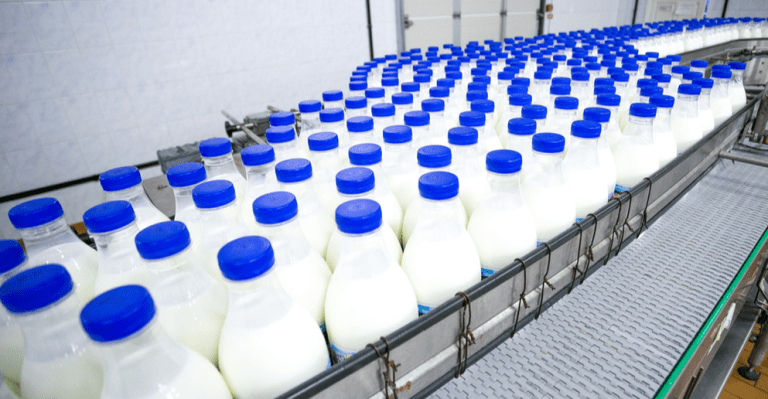
USDA forecasts that milk production in the U.S. will rise by 2.1% in 2021 thanks to gains in yield per cow as well as a slight increase in the number of milk cows. The average yearly price received by farmers for cow milk in 2021 is predicted to grow by 3.9% y-o-y amidst a rally in prices for animal feed. Rising consumer demand for cheese and butter continues to drive the market on the backdrop of lower demand for beverage milk. Demand in Asia for imported dairy products features as another factor boosting milk processing in the U.S.
Key Trends and Insights
According to IndexBox, in 2020, U.S. milk production increased by 1.3% y-o-y to 100M tonnes, and it is forecast to rise at the same pace for the next two years due to demand from the growing population.
The average number of milk cows in the U.S. rose from 9,337 heads in 2019 to 9,388 heads in 2020 but remains below the 2017-2018 figures. In the second half of 2021 and into 2022, farmers are expected to accelerate the pace of butchering and decrease the total head of cattle as they respond to higher costs of feed resulting from summer droughts. The expected decline in milk due to fewer cattle should be offset by increased milk production per cow.
The USDA estimates that as of year-end 2021, the average yearly farmer’s price will grow by 3.9% y-o-y to $0.43 per liter due to rallying feed prices. In 2022, the cost of milk should fall by 2.4% in comparison with 2021 to $0.42 per liter thanks to the expected increase in production but will remain higher than the 2020 figures ($0.41 per liter).
Over the last decade, the per capita milk consumption in the U.S., incl. both fresh milk of all kinds and milk used for processing, grew by 6.7% and in 2020 reached 354 kg/person, but the structure of the demand has been changing. Americans continue drinking less milk while consuming more cheese and butter. This long-term shift towards processed dairy products will drive market growth for milk in the mid-term. In Asia, imported produce is becoming highly sought after and this should expand exports of American cheese and other dairy products, while additionally driving demand for milk.
U.S. Milk Production
In 2020, approx. 118M tonnes of milk were produced in the U.S.; picking up by 1.6% compared with 2019 figures. The total output volume increased at an average annual rate of +1.3% from 2012 to 2020; the trend pattern remained consistent, with somewhat noticeable fluctuations being recorded throughout the analyzed period. The pace of growth appeared the most rapid in 2014 when the production volume increased by 2.7% year-to-year. Milk production peaked in 2020 and is expected to retain growth in the immediate term.
In value terms, milk production expanded significantly to $127.8B in 2020. The total output value increased at an average annual rate of +4.4% over the period from 2012 to 2020; the trend pattern indicated some noticeable fluctuations being recorded in certain years. Milk production peaked at $130.4B in 2017; however, from 2018 to 2020, production remained at a lower figure.
U.S. Milk Imports
For the third consecutive year, the U.S. recorded growth in purchases abroad of milk, which increased by 7.2% to 19K tonnes in 2020. Overall, imports recorded buoyant growth. The pace of growth appeared the most rapid in 2016 when imports increased by 51% against the previous year. Over the period under review, imports hit record highs in 2020 and are expected to retain growth in years to come (IndexBox estimates).
In value terms, milk imports dropped rapidly to $22M in 2020. Overall, imports posted a strong increase. The pace of growth appeared the most rapid in 2018 when imports increased by 24% year-to-year. As a result, imports reached a peak of $30M. from 2019 to 2020, the growth of imports remained at a lower figure.
In 2020, whole fresh milk (31K tonnes) constituted the largest type of milk supplied to the U.S., with a 68% share of total imports. Moreover, whole fresh milk exceeded the figures recorded for the second-largest type, skim milk of cows (14K tonnes), twofold.
Canada (25K tonnes), Mexico (16K tonnes) and New Zealand (818 tonnes) were the main suppliers of milk imports to the U.S. In value terms, Mexico ($35M), Canada ($25M) and New Zealand ($1.9M) appeared to be the largest milk suppliers to the U.S.
In 2020, the average milk import price amounted to $1,157 per tonne, waning by -21.3% against the previous year. There were significant differences in the average prices amongst the major supplying countries. In 2020, the country with the highest price was New Zealand ($2,270 per tonne), while the price for Canada ($997 per tonne) was amongst the lowest.
Source: IndexBox Platform
























